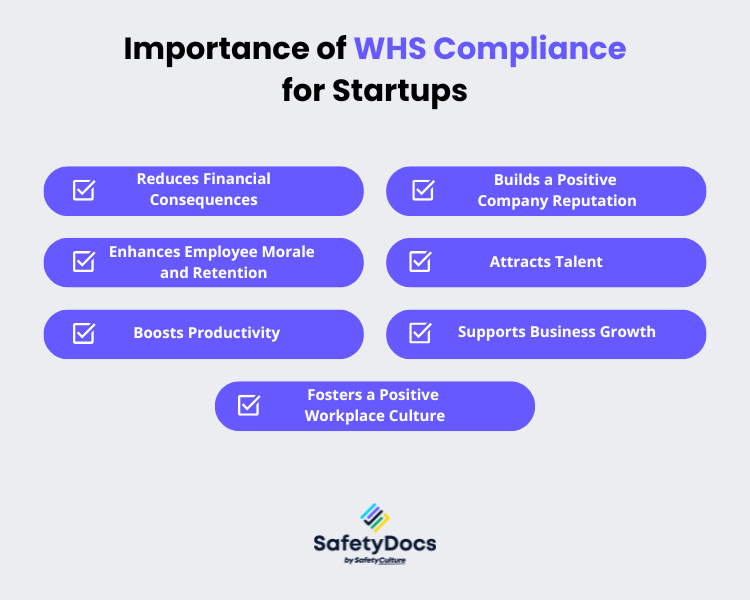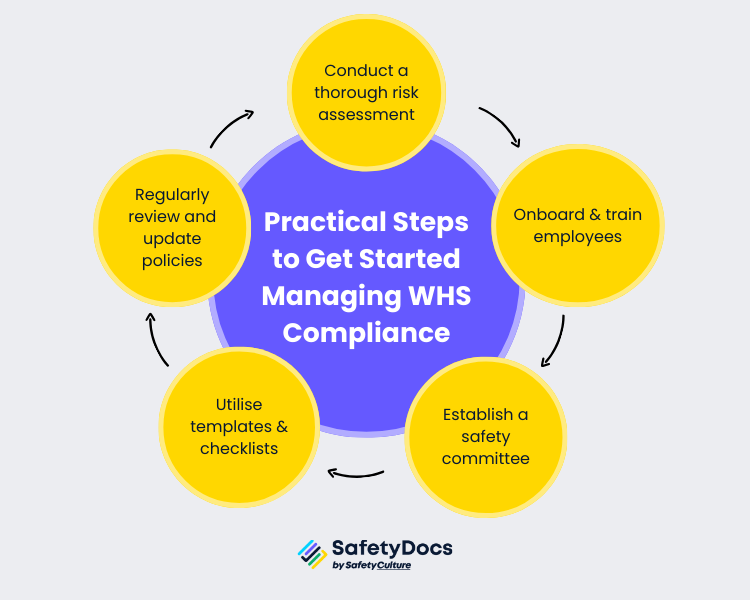Are you a business startup wondering if you need to worry about WHS laws compliance? The answer is yes. Under Work Health and Safety (WHS) laws, starting a business in Australia means you are responsible for ensuring a safe working environment. WHS should be a priority for any business, regardless of size or industry. This guide will simplify the WHS essentials for startups and provide tips on integrating inclusiveness and psychosocial safety into your framework.
What is WHS Compliance?
Work Health and Safety (WHS) compliance refers to the legal obligations of businesses to ensure the safety and health of their workers and others present in the workplace. In Australia, WHS compliance is structured through a combination of legislation, regulations, and codes of practice, which can vary across different states and territories. Below is an overview of the key components:
Jurisdictional Differences and Safe Work Australia
Safe Work Australia develops the Model WHS laws to harmonise safety standards nationwide. However, enforcement and implementation are the responsibility of state and territory regulators. For example:
- Most states and territories, including New South Wales, Queensland, and Western Australia, have adopted the Model WHS laws.
- Victoria operates under its own legislation, the Occupational Health and Safety Act 2004 (Vic). Businesses operating in Victoria must comply with its unique provisions while ensuring workplace safety.
Model Work Health and Safety (WHS) Act
The Model WHS Act is the foundation for most workplace safety legislation in Australia, outlining the duties of Persons Conducting a Business or Undertaking (PCBUs). Each jurisdiction enforces its version of the WHS Act through its state or territory regulator, so businesses must ensure they comply with the specific requirements where they operate.
Work Health and Safety Regulations
WHS Regulations provide detailed requirements for specific hazards and risk management strategies. They cover hazardous substances, manual handling, machinery operation, and asbestos management.
Codes of Practice
Codes of Practice are practical guidelines that help businesses comply with WHS laws. Some examples of model codes include the "Code of Practice for Manual Handling" and "Managing the Work Environment and Facilities." Complying with a Code of Practice is considered evidence of meeting legal obligations.
Consult Your State or Territory Regulator
Because WHS laws are administered at the state and territory level, it's crucial for all business owners to check with their specific regulators to understand and comply with the applicable legislation.
Fair Work Act (For Employee Safety)
Though primarily an employment law, the Fair Work Act underscores the importance of worker protection. It primarily governs employment conditions, including minimum wages, work hours, leave entitlements, and protections against unfair dismissal. It also promotes workplace safety and fair treatment. It interconnects with WHS obligations to ensure employees are not exposed to unsafe conditions.
Employer Responsibilities
- Duty of Care: Employers must ensure the health and safety of employees, contractors, and visitors.
- Risk Management: Regularly identify, assess, and minimise workplace hazards.
- Worker Consultation: Actively involve employees in discussions about WHS policies and risks.
- Incident Reporting: Record workplace injuries and report severe incidents to local WHS regulators.
- Training and Supervision: Provide employees with adequate information, training, and supervision to perform their work safely.

Importance of WHS Compliance for Startups
The primary laws mentioned above are why startups must pay attention to WHS compliance. Compliance is non-negotiable, but the benefits go far beyond adhering to the law. Here's why WHS compliance matters and how it can positively impact your business:
1. Reduces Financial Consequences
New businesses often struggle with limited resources and knowledge about WHS law. Not complying can lead to fines, legal issues, damage to reputation, and reduced productivity. Startups also tend to have higher employee turnover. Failing to follow safety laws and rules can cause injuries, illnesses, and legal problems. Workplace injuries can financially drain startups, resulting in high costs that seriously harm a new business.
2. Enhances Employee Morale and Retention
A safe and healthy work environment shows employees that you value their well-being. When workers feel secure in their workplace, they're more likely to be loyal, motivated, and engaged. For startups, which often face stiff competition for top talent, having a reputation for prioritising work health and safety, can make a big difference in retaining skilled and dedicated staff.
3. Boosts Productivity
Employees who feel safe focus more on their work than worrying about potential illness or hazards. A culture of safety not only reduces downtime caused by accidents or illness but fosters an environment where employees perform at their best. For startups that often operate on tight timelines, maintaining productivity is vital.
4. Builds a Positive Company Reputation
A commitment to WHS can enhance your startup or small business's reputation among customers, partners, and investors. Being seen as a responsible and safety-conscious business fosters trust and credibility in the market, giving you a competitive edge. A strong safety record can also open doors to contracts that require strict compliance standards.
5. Attracts Talent
Startups need the best people on board to grow and succeed. A safe and supportive work environment can attract top talent, and prospective employees are more likely to choose a startup where they feel their own health and safety are prioritised.
6. Supports Business Growth
WHS compliance is foundational for sustainable growth. By embedding these safety requirements into your operations early on, you create a robust framework that adapts as your startup scales. Over time, this leads to fewer disruptions, better team cohesion, and a culture of accountability that sets the stage for long-term success.
7. Fosters a Positive Workplace Culture
A commitment to WHS clearly shows that people are your priority. This fosters trust, transparency, and collaboration among employees. A supportive work culture, in turn, drives innovation and creativity - key ingredients for startup success.

Core Safety Policies for Compliance
Core safety policies are the foundation for a robust WHS framework in startups. These policies not only help meet legal obligations but also pave the way for long-term success. Below are the core safety policies that every startup should implement:
- Risk Assessment and Management Policy: The purpose is to identify potential hazards and assess risks to prevent accidents or injuries.
- Emergency Procedures Policy: To prepare employees to respond effectively to fires, natural disasters, or chemical spills.
- Employee Training and Education Policy: To equip employees with the knowledge and skills to perform their roles safely.
- Incident Reporting and Investigation Policy: To document and analyse incidents to prevent future occurrences.
- Personal Protective Equipment (PPE) Policy: To protect employees from hazards that cannot be eliminated through other controls.
- Health and Well-Being Support Policy: To promote overall occupational health, focus on both physical and mental well-being.
Additional Considerations for Startups
Aside from the core safety policies, startups should also consider incorporating the Inclusiveness and Psychosocial Safety policies. These policies promote a culture of inclusivity and support employees' mental health.
- Diversity & Inclusion Policy: Encourages diversity, equity, and inclusion in the workplace to create a safe and welcoming environment
- Psychosocial Risk Policy: Mental health is an important aspect of workplace safety, and this policy addresses the prevention and management of work-related stressors that can negatively impact employees.
Practical Steps to Get Started
Understanding WHS compliance is crucial for startups. Here are some practical steps to implement a strong safety framework:
Conduct a Thorough Risk Assessment
Everything starts with identifying potential hazards and assessing risks. This step is crucial for understanding the specific safety needs of your startup and determining which policies to prioritise.
Onboard and Train Employees
Proper onboarding and training are essential for ensuring that all employees know WHS policies, procedures safety duties, and responsibilities. This should include regular refresher training to keep everyone up to date.
Establish a Safety Committee
A safety committee helps create, monitor, and review safety policies. It should include members from all organisation levels for a complete and inclusive approach.
Utilise Templates and Checklists
Premade WHS templates and checklists can save time and resources. This is a quick win for startups, especially when resources are limited. They can be easily adapted to meet your startup's specific needs. They also help you implement and comply with safety policies, procedures, and legal requirements.
Regularly Review and Update Policies
It's important to periodically review and update your policies to ensure they are up-to-date with changing regulations and reflect your startup's evolving needs. This also helps identify any potential gaps in your safety framework.

Start Your Compliance Journey With SafetyDocs
Let us provide the resources you need to build a robust WHS framework for your startup. SafetyDocs by SafetyCulture offers a wide range of safety templates, checklists, and policies to help you streamline compliance and promote a safer workplace.
Get started today by exploring our library of WHS resources and start your journey towards a safer, more productive workplace.
Remember, safety is not just about compliance - it's about caring for the people who make your startup thrive. So, prioritise their well-being and take the necessary steps to ensure a safe and healthy work environment. Contact us today for more information on how SafetyDocs can help.
Our team of experts is dedicated to providing accurate and informative content. Craig Cruickshank, our senior HSEQ advisor at SafetyDocs by SafetyCulture has reviewed this blog post to ensure the highest level of quality.
Learn more about Craig's work on LinkedIn for more industry insights.
Available for instant download and supplied in fully editable MS Word format for use in your business.
Please note that the above information is provided as a comment only and should not be relied on as professional, legal or financial advice.
Share This Article
